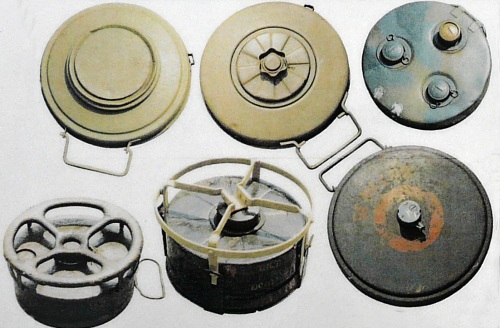Company B, 303rd Combat Engineer Battalion,
78th Infantry Division

Source: Article in the Buffalo News - Amid land mines, pure heroism
By Lou Michel
When Herbert R. Falk reflects back on the early morning of Feb. 6, 1945, he still can't grasp what came over him to commit a sudden act of gallantry.
He was assigned to a unit that specialized in removing land mines and was walking under the cover of woods with members of the infantry toward the German town of Schmidt when U.S. tanks, which didn't have the same benefit of wooded camouflage, came to a halt on a narrow road running parallel to the forest.
Several partially buried land mines had been spotted. Making matters worse, the tanks had stopped at the bottom of a hill, and the enemy was dug in on top.
Usually, Falk and other combat engineers would work as a team in removing the mines, which, in this case, were powerful enough to shatter the steel tracks of a tank.

German anti-tank mines
"They were big mines," he recalled, "at least 14 inches round and about 3 inches thick," he recalled.
In this exposed situation at the base of the hill, a squad of eight mine removers would be nothing less than sitting ducks. So a call went out for a single volunteer to remove the mines blocking the tanks' path.
Falk heard and answered the cry for help.
"I must have been crazy, but I volunteered. I still don't know why I did it," he said in pondering that moment.
He ran out of the protective woods and, one at a time, grabbed the handle atop each mine and carefully placed it on the side of the road. The enemy did not take kindly.
"I heard a whoosh and then an explosion next to me, and I didn't know what the heck happened. I fell over and looked down at my field jacket and saw blood."
He quickly realized he was on the receiving end of mortar shells.
What was needed was more heroism -- and luckily plenty was on hand.
Four members of his squad ran onto the road and grabbed hold of his arms and legs and dragged him back to safety. The tank column resumed its climb up the hill while Falk's buddies hauled him beyond the range of the mortars and placed him on the hood of a jeep.
He was transported to a first-aid station and later to a hospital in Brussels.
"Then I went to a hospital in Paris where they put a skin graft on my right arm, and I was sent to a recovery hospital in Kidderminster, England."
After two months of recovery, he was sent back to his outfit in Germany.
"We occupied farm country, and in November I got out while the rest of my unit went to Berlin for occupation," he said.
Home in the United States, Falk made use of the G.I. Bill and attended the University of Utah, where he earned a civil engineering degree. He settled in Western New York more than 40 years ago.
Proud of his affiliation with the Jewish War Veterans Post 25, he says he still attends post meetings every few months at Temple Beth Am on Sheridan Drive, Amherst.
"I served as post commander," he says with pride. "Most of the members in the post are World War II veterans. There's about 85 of us."
As for that morning so long ago in Germany on the heavily mined road, Falk says it remains ever so vivid.
"Every time I think about, I can see it very, very clearly."
~~~ Herbert R. Falk ~~~

Herbert Falk, with a display of his medals from his service in World War II,
a Purple Heart, a Silver Star and a French Croix de Guerre,
taken at his home in East Amherst on Nov. 1 , 2010
(Buffalo News file photo)

In remembrance of Herbert R Flak
May 30, 1921 – †Jan. 19, 2022
